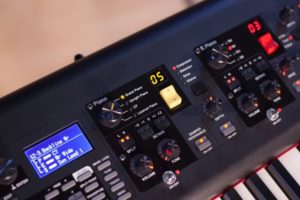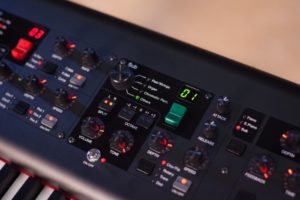Yes, I played one! The pandemic has let up to the point where I can drag my old bod to music stores, again. Fortunately, I haven’t worn out my welcome with local shop owners and clerks (yet).
I don’t intend to run down the DGX-670 features in detail. The Yamaha DGX-670 has been on the market for two+ years and you can find all the details on the Yamaha Web page. Yamaha position the DGX as a “portable grand piano,” part of the “P” line of digital piano products.
And, as of late, my primary interest is in a digital piano that will help me to sharpen my piano skills. I want those skills to translate to the acoustic piano (Petrof acoustic grand) at church.
In that regard, the DGX-670 does not disappoint. The action is Graded Hammer Standard (GHS) and the main piano multi-sample is Yamaha CFX. The 670 has Yamaha’s Virtual Resonance Modeling (VRM) which “reproduces the complicated interaction between both string and soundboard resonance.” The CFX sounds very good through the in-built amplification and speaker system: 2 x 6 Watt amplifier, 2 x (12cm + 5cm) speakers. If I have one immediate slam on the DGX-670, its front panel legends are difficult to read in poor light (black model).
In short, the DGX-670 has me asking, “Do I really need to move up to the Yamaha P-515 digital piano?” This question is more complicated than it sounds, especially when you roll the Yamaha CK88 into the analysis!
The DGX-670 street price is $850 USD versus $1,600 for the P-515. The store which hosted my adventure was prepared to discount the DGX-670 to $750 — that’s half of a P-515. That’s half of a Yamaha CK88, too ($1,500 MAP).
It comes down to personal musical goals — and desire. 🙂 Let’s take each alternative separately.
The P-515 has the Natural Wood X action with escapement (NWX) and the glorious Bösendorfer Imperial. That’s a lot to argue against. The P-515 sound system is more capable: 2 x (15W + 5W biamplified) amplifier, and 2 x (12cm x 6cm) woofer and 2 x 2.5cm dome. The DGX-670 has a very nice 4.3 inch (480 × 272 dots) LCD display that adds a splash of color to Yamaha’s drab black. The P-515 display has less resolution (128 x 64 dots) and is monochrome. [Yamaha should adopt the color display for the P-515 successor].
Those P-515 characteristics would be easy to live with. My biggest beef with the P-515, however, is the paucity and lower quality of its non-piano (AP or EP) sounds. The DGX-670 outstrips the P-515 for non-piano sounds. I quickly compared the DGX-670 voices against my once-beloved, owned and played PSR-S950. The DGX-670 is (roughly) a PSR-S950 without the Organ Flutes drawbar organ. I know these voices and would be very happy to have them in my piano instrument.
As to auto-accompaniment, the DGX-670 is “arranger lite.” It has styles and chord recognition. The styles are now represented in the Style File Format Guitar Edition (SFF GE) form. SFF GE makes the DGX-670 compatible with styles from the mid- and upper-end Yamaha arranger keyboards. A virtual ocean of styles are available at the PSR Tutorial web site as well as a growing community of DGX-670 players on the PSR Tutorial forum.
Yamaha do not say much about P-515 auto-accompaniment other than it’s bass plus drum, and that it follows chords. What is P-515’s chord recognition technique? Is it similar to full keyboard, A.I. recognition? Wish I knew more about this aspect of the P-515…
Regular visitors know that I test drove the Yamaha CK88, too. The CK88 is positioned in Yamaha’s stage keyboard product line. The sound system is comparable to the DGX-670: 2 x 6 Watt amplifier and 2 x (12cm x 6cm) speakers. The CK88 has the lower resolution (128×64 dots) monochrome display.
Piano-wise, the CK88 has the CFX multi-sample and GHS keybed. No VRM. No Bösendorfer. The CKs are well-equipped for drawbar and pipe organ. (The pipe organ multi-samples originated on Genos™.) The DGX-670 — and P-515, for that matter — are relatively deficient in the drawbar and pipe organ department. The CKs have a good selection of other non-piano voices. No Super Articulation. The CKs do not have auto-accompaniment of any kind.
So, if a player doesn’t care about drawbar organ and wants VRM, why not DGX-670 at half the price of a CK88?
At this point, I would be remiss to not mention slab weight:
DGX-670 weight: 47.1 pounds (21.4kg)
P-515 weight: 48.5 pounds (22.0kg)
CK88 weight: 28.8 pounds (13.1kg)
Yamaha’s engineers did a remarkable job of slimming the CK88 down to 28.8 pounds. The respectable GHS-equipped P-125 is 26 pounds and I doubt if Yamaha can design a lighter, robust, 88-key GHS keyboard.
I neglected the whole issue of connectivity and app support. Your mileage will vary. The DGX-670 does not have 5-pin DIN MIDI. That might be a deal-breaker for some folks. Smart Pianist does not presently support CK88. Look to Yamaha Soundmondo, instead.
I didn’t work the Yamaha CP88 into the analysis. After its updates, the CP88 is a virtual library of pianos! It’s also $2,600 USD (MAP), $1,000 higher than the three digital pianos in my analysis.
Finally, why did I enjoy playing the DGX-670 GHS and not so much the CK88. Yamaha swears that the GHS action is the same everywhere. If there is an external factor, perhaps it is the insane way trial pianos are set-up in stores? Often, I feel like a contortionist. (Forget reading sheet music in some settings, too.) Playing piano is, after all, a physical act.
If you enjoyed this analysis, please check out my comments about the Yamaha P-S500. I compare the P-S500 against the DGX-670.
Other reviews and comments about digital pianos:
- Yamaha P-S500 digital piano
- Yamaha CK88 stage keyboard (review)
- Yamaha P-515 portable digital piano (review)
- Yamaha DGX-670 portable grand piano (snap review)
- Yamaha Piaggero NP-15 and NP-35 portable digital pianos (announcement)
- Korg Liano digital piano (announcement)
- Roland FP-E50 digital piano with auto-accompaniment
- Yamaha CSP series digital pianos
Copyright © 2023 Paul J. Drongowski




